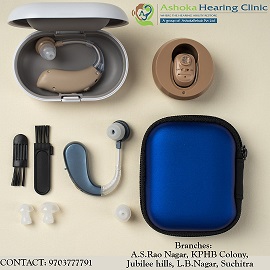


Hearing aids are sophisticated devices designed to amplify sound and improve hearing for individuals with hearing loss.
Hearing loss is a common condition that can affect individuals of all ages, that can arise from various factors such as aging, exposure to loud noise, genetics, and medical conditions. When left untreated, hearing loss can lead to social isolation, reduced cognitive function, and decreased quality of life.
Hearing aids are sophisticated devices designed to amplify sound and improve hearing for individuals with hearing loss. They work by capturing sound waves, processing them, and delivering amplified sound signals to the ear. With advancements in technology, modern hearing aids offer a range of features to address different types and degrees of hearing loss, catering to individual preferences and lifestyles.
Types of Hearing Aids:
BTE hearing aids consist of a small plastic case worn behind the ear, connected to a custom earmold or earpiece via tubing.
They are suitable for individuals with mild to profound hearing loss.
BTE devices are known for their durability and ease of handling, making them popular among users of all ages.
ITE hearing aids are custom-molded to fit directly into the ear canal or outer portion of the ear.
They are available in different sizes, including full-shell, half-shell, and canal styles.
ITE devices offer discreetness and are suitable for mild to severe hearing loss.
ITC and CIC hearing aids are small and discreet, fitting partially or completely into the ear canal.
They are less visible than BTE and ITE devices, appealing to users seeking a cosmetically appealing option.
ITC and CIC hearing aids are suitable for mild to moderate hearing loss.
RIC hearing aids feature a small casing behind the ear, with a thin wire connecting to a receiver located in the ear canal.
They offer a comfortable fit and natural sound quality, making them suitable for mild to severe hearing loss.
RIC devices are popular for their discreetness and ability to accommodate various ear canal sizes.
Choosing the Right Hearing Aid:
Selecting the right hearing aid involves considering several factors, including the type and degree of hearing loss, lifestyle preferences, budget, and cosmetic concerns. Here are some steps to guide you through the process:
Schedule an appointment with a qualified audiologist for a comprehensive hearing assessment.
Discuss your hearing concerns, lifestyle, and communication needs with the audiologist to determine the most suitable hearing aid options.
Explore the technological capabilities and features offered by different hearing aid models, such as noise reduction, directional microphones, telecoil compatibility, and connectivity options.
Choose features that align with your hearing preferences and daily activities.
Ensure proper fitting of the hearing aid to maximize comfort and effectiveness.
Consider factors such as size, shape, and wearing style to find a device that suits your individual needs and preferences.
Take advantage of trial periods offered by hearing aid providers to test the device in various environments and situations.
Provide feedback to your audiologist regarding the comfort, performance, and effectiveness of the hearing aid during the trial period.
Schedule follow-up appointments with your audiologist for adjustments, fine-tuning, and ongoing support.
Communicate any issues or concerns you may have with the hearing aid to ensure optimal performance and satisfaction.
